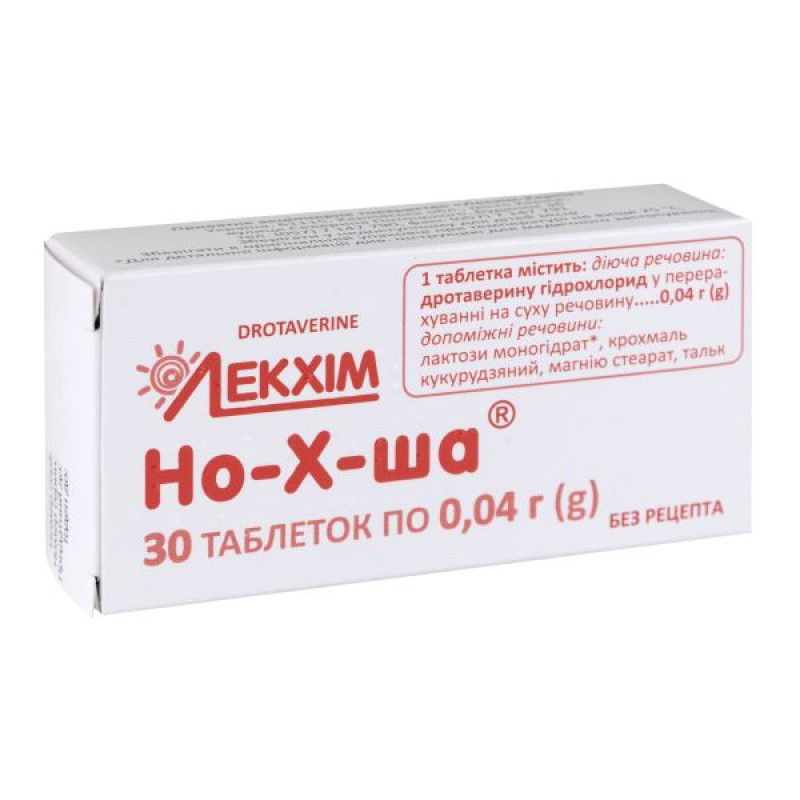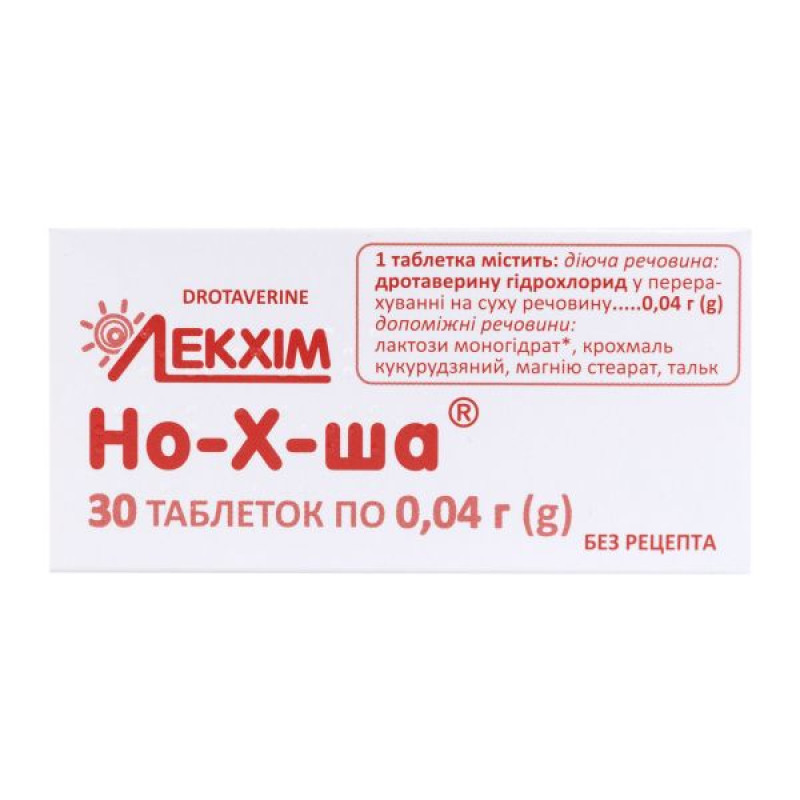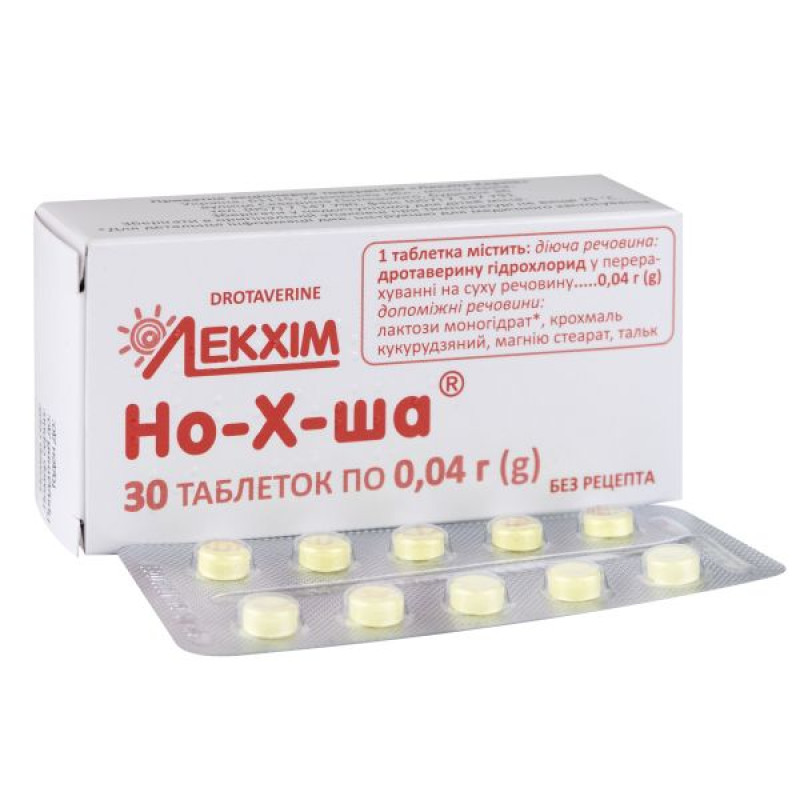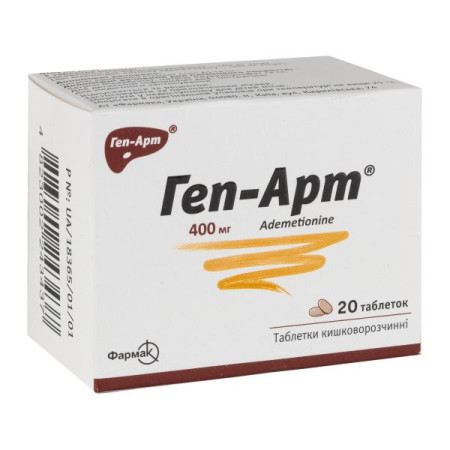No-x-sha tablets 0.04 g blister No. 30

Translation of the instructions can be
NO-X-SHA® solution for injection 20 mg/mlInstruction
For medical use of the medicinal product
No-h-sha®
(No-h-sha®)
Composition:
Active ingredient: drotaverine;
1 ml of solution contains 20 mg of drotaverine hydrochloride in terms of dry matter;
excipients: ethanol 96%, sodium metabisulfite (E 223), water for injections.
Dosage form.
Solution for injection.
Main physicochemical properties: clear liquid of greenish-yellow color.
Pharmacotherapeutic group.
Drugs used for functional gastrointestinal disorders. drotaverine.
PBX code A03A D02.
Pharmacological properties.
Pharmacodynamics.
Drotaverine is an isoquinoline derivative that exhibits an antispasmodic effect on smooth muscles by inhibiting the action of the enzyme phosphodiesterase IV (PDE IV), which leads to an increase in the concentration of cAMP and, due to the inactivation of myosin light chain kinase (MLCK), to relaxation of smooth muscles.
In vitro, drotaverine inhibits the action of the enzyme phosphodiesterase IV and does not affect the action of the isoenzymes phosphodiesterase III (PDE III) and phosphodiesterase V (PDE V). PDE IV is of great functional importance for reducing the contractile activity of smooth muscles, therefore, selective inhibitors of this enzyme may be useful for the treatment of diseases accompanied by hypermotility, as well as various diseases in which spasms of the gastrointestinal tract occur.
In myocardial and vascular smooth muscle cells, cAMP is hydrolyzed mainly by the PDE III isoenzyme, therefore drotaverine is an effective antispasmodic that does not have significant side effects on the cardiovascular system and has a strong therapeutic effect on this system.
Drotaverine is effective in smooth muscle spasms of both nervous and muscular origin. Drotaverine acts on the smooth muscles of the gastrointestinal, biliary, genitourinary and vascular systems, regardless of the type of their autonomic innervation.
It increases blood circulation in tissues due to its ability to dilate blood vessels.
The action of drotaverine is stronger than that of papaverine, absorption is faster and more complete, it binds less to serum proteins. The advantage of drotaverine is also that, unlike papaverine, after its parenteral administration, there is no such side effect as respiratory stimulation.
Pharmacokinetics.
Drotaverine is rapidly and completely absorbed after parenteral administration. It is highly (95-98%) bound to human plasma proteins, especially albumin, gamma- and beta-globulins. After primary metabolism, 65% of the administered dose enters the bloodstream unchanged.
Metabolized in the liver. The half-life of biological existence is 8-10 hours.
Within 72 hours, drotaverine is almost completely excreted from the body, about 50% is excreted in the urine and about 30% in the feces. Drotaverine is mainly excreted in the form of metabolites, it is not detected in unchanged form in the urine.
Clinical characteristics.
Indication.
Smooth muscle spasms associated with biliary tract diseases: cholecystolithiasis, cholangiolithiasis, cholecystitis, pericholecystitis, cholangitis, papillitis.
Spasms of smooth muscles in diseases of the urinary tract: nephrolithiasis, urethrolithiasis, pyelitis, cystitis, bladder tenesmus.
As an adjunctive treatment (if the use of the drug in tablet form is not possible):
for spasms of smooth muscles of the gastrointestinal tract: gastric and duodenal ulcers, gastritis, cardio- and/or pylorospasm, enteritis, colitis; for gynecological diseases: dysmenorrhea.Contraindication.
Hypersensitivity to the active substance or to any component of the drug (especially to sodium metabisulfite); hypersensitivity to sodium disulfite; severe hepatic, renal or heart failure (small cardiac output syndrome).Interaction with other drugs and other types of interactions.
Phosphodiesterase inhibitors (drotaverine, papaverine) reduce the antiparkinsonian effect of levodopa. The drug should be used with caution simultaneously with levodopa, since the antiparkinsonian effect of the latter is reduced, and rigidity and tremor are increased.
Application features.
Due to the risk of collapse during intravenous administration of the drug, the patient must be in a supine position!
Use with caution in hypotension.
The drug contains metabisulfite, which may cause allergic-type reactions, including symptoms of anaphylactic shock and bronchospasm in susceptible patients, especially those with a history of asthma or allergies. In case of hypersensitivity to sodium metabisulfite, parenteral administration of the drug should be avoided.
Caution should be exercised when parenterally administering the drug to pregnant women (see section "Use during pregnancy or lactation").
Children: Clinical studies of the drug in children have not been conducted.
Use during pregnancy or breastfeeding.
Pregnancy. As shown by the results of retrospective clinical studies, oral administration of the drug did not cause any teratogenicity or embryotoxicity in any case. However, caution should be exercised when prescribing the drug to pregnant women. Do not use drotaverine during labor.
Fertility: There are no data on the effect on human fertility.
The ability to influence the reaction speed when driving vehicles or other mechanisms.
Patients should be warned that after parenteral, especially intravenous, administration of the drug, it is recommended to refrain from driving and performing work that requires increased attention.
Method of administration and doses.
The usual average daily dose for adults is 40-240 mg (in 1-3 separate injections) intramuscularly.
For acute colic in adult patients with calculi in the urinary or biliary tract - 40-80 mg intravenously.
Children.
Clinical studies of the drug in children have not been conducted.
Overdose.
Symptoms: Overdose with drotaverine has been associated with cardiac rhythm and conduction disturbances, including complete bundle branch block and cardiac arrest, which can be fatal.
In case of overdose, the patient should be under close medical supervision and receive symptomatic treatment, which includes induction of vomiting and/or gastric lavage.
Adverse reactions.
Side effects observed during clinical trials and possibly caused by drotaverine are distributed across organ systems.
From the immune system.
Allergic reactions, including angioedema, urticaria, rash, itching, fever, chills, increased body temperature, weakness, especially in patients with hypersensitivity to metabisulfite.
Cases of anaphylactic shock with fatal and non-fatal outcomes have also been reported with the injectable form.
The drug contains metabisulfite, which may cause allergic-type reactions, including symptoms of anaphylactic shock and bronchospasm in sensitive patients, especially those with a history of asthma or allergies.
From the cardiovascular system.
Rapid heartbeat, hypotension.
From the nervous system.
Headache, dizziness, insomnia.
From the gastrointestinal tract.
Nausea, constipation, vomiting.
General disorders and administration site reactions.
Local reactions at the injection site.
Expiration date.
3 years.
Storage conditions.
Store out of the reach of children in the original packaging at a temperature not exceeding 25 °C.
Packaging.
2 ml in ampoules. 5 or 100 ampoules in a pack; or 5 ampoules in a blister, 1 blister in a pack.
Vacation category.
According to the recipe.
Producer.
Private Joint-Stock Company "Lekhim-Kharkiv".
Location of production and its address of place of business.
Ukraine, 61115, Kharkiv region, Kharkiv city, Severyna Pototskoho street, building 36.
NO-X-SHA® tablets 0.04 gInstruction
For medical use of the medicinal product
No-h-sha®
(No-h-sha®)
Composition:
Active ingredient: drotaverine;
1 tablet contains: drotaverine hydrochloride in terms of dry matter 40 mg (0.04 g);
excipients: lactose, corn starch, magnesium stearate, talc.
Dosage form.
Pills.
Main physicochemical properties: tablets from light yellow to yellowish-green in color.
Pharmacotherapeutic group.
Drugs used for functional gastrointestinal disorders.
PBX code A03A D02.
Pharmacological properties.
Pharmacodynamics.
Drotaverine is an isoquinoline derivative that exerts an antispasmodic effect directly on smooth muscle by inhibiting the action of the enzyme phosphodiesterase IV (PDE IV), which causes an increase in the concentration of cAMP and, due to the inactivation of myosin light link kinase (MLCK), leads to relaxation of smooth muscle.
In vitro, drotaverine inhibits the action of the PDE IV enzyme and does not affect the action of the isoenzymes phosphodiesterase III (PDE III) and phosphodiesterase V (PDE V). PDE IV is of great functional importance for reducing the contractile activity of smooth muscles, therefore, selective inhibitors of this enzyme may be useful for the treatment of diseases accompanied by hypermotility, as well as for the treatment of various diseases in which gastrointestinal spasms occur.
In myocardial and vascular smooth muscle cells, cAMP is hydrolyzed mainly by the PDE III isoenzyme, therefore drotaverine is an effective antispasmodic that does not have significant side effects on the cardiovascular system and a strong therapeutic effect on this system.
Drotaverine is effective in smooth muscle spasms of both nervous and muscular origin. Drotaverine acts on the smooth muscles of the gastrointestinal, biliary, genitourinary and vascular systems, regardless of the type of their autonomic innervation.
It enhances blood circulation in tissues due to its ability to dilate blood vessels.
Pharmacokinetics.
The effect of drotaverine is stronger than that of papaverine, absorption is faster and more complete, it binds less to serum proteins. The advantage of drotaverine is also that, unlike papaverine, after its parenteral administration, there is no such side effect as respiratory stimulation.
Metabolized in the liver. The half-life is 8-10 hours.
Within 72 hours, drotaverine is almost completely excreted from the body, more than 50% is excreted in the urine and about 30% in the feces. Drotaverine is mainly excreted in the form of metabolites, unchanged in the urine is not detected.
Clinical characteristics.
Indication.
For therapeutic purposes in:
smooth muscle spasms associated with biliary tract diseases: cholecystolithiasis, cholangiolithiasis, cholecystitis, pericholecystitis, cholangitis, papilloma; smooth muscle spasms in urinary tract diseases: nephrolithiasis, urethrolithiasis, pyelitis, cystitis, bladder tenesmus.As an adjunctive treatment for:
spasms of smooth muscles of the gastrointestinal tract: gastric and duodenal ulcers, gastritis, cardio- and / or pylorospasm, enteritis, colitis, spastic colitis with constipation and irritable bowel syndrome, accompanied by flatulence; tension headache; gynecological diseases (dysmenorrhea).Contraindication.
Hypersensitivity to drotaverine or to any component of the drug. Severe hepatic, renal or heart failure (small cardiac output syndrome).
Interaction with other drugs and other types of interactions.
Phosphodiesterase inhibitors, such as papaverine, reduce the antiparkinsonian effect of levodopa.
Caution should be exercised when using No-X-sha ® simultaneously with levodopa, as the antiparkinsonian effect of the latter is reduced and rigidity and tremor are increased.
Application features.
Use with extreme caution in hypotension.
No-X-sha ® tablets contain lactose. Do not use in patients with rare hereditary problems of galactose intolerance, the Lapp lactase deficiency or glucose-galactose malabsorption.
Use during pregnancy or breastfeeding.
Pregnancy. As shown by the results of retrospective clinical studies and animal studies, oral administration of the drug did not cause any signs of any direct or indirect effect on pregnancy, embryonic development, childbirth or postnatal development. However, caution should be exercised when prescribing the drug to pregnant women.
Breastfeeding. Due to the lack of data, the use of the drug during breastfeeding is not recommended.
The ability to influence the reaction speed when driving vehicles or other mechanisms.
If patients experience dizziness after using the drug, they should avoid potentially dangerous activities, such as driving a car and performing work that requires increased attention.
Method of administration and doses.
Adults: The usual average dose is 120-240 mg per day in 2-3 divided doses.
When using drotaverine in children:
for children 6-12 years old, the maximum daily dose is 80 mg (divided into 2 doses);
For children over 12 years of age, the maximum daily dose is 160 mg (divided into 2-4 doses).
Children.
The use of the drug is contraindicated in children under 6 years of age.
The use of drotaverine in children has not been evaluated in clinical studies.
Overdose.
Symptoms: with a significant overdose of drotaverine, cardiac rhythm and conduction disturbances have been observed, including complete bundle branch block and cardiac arrest, which can be fatal.
In case of overdose, the patient should be under close medical supervision and receive symptomatic treatment, including induction of vomiting and/or gastric lavage.
Adverse reactions.
Side effects observed during clinical trials and possibly caused by drotaverine are distributed across organ systems.
On the part of the immune system: allergic reactions, including angioedema, urticaria, rash, itching, redness of the skin, fever, chills, increased body temperature, weakness.
Cardiovascular system: palpitations, hypotension.
From the nervous system: headache, dizziness, insomnia.
Gastrointestinal: nausea, constipation, vomiting.
Expiration date.
5 years.
Storage conditions.
Store in the original packaging at a temperature not exceeding 25 °C.
Keep out of reach of children.
Packaging.
10 tablets in a blister, 1 or 3 blisters in a pack.
Vacation category.
Without a prescription.
Producer.
Private Joint-Stock Company "Lekhim-Kharkiv".
Location of production and its address of place of business.
Ukraine, 61115, Kharkiv region, Kharkiv city, Severyna Pototskoho street, building 36.
NO-X-SHA® rectal suppositories 0.04 gInstruction
For medical use of the medicinal product
No-h-sha®
(No-h-sha®)
Composition:
Active ingredient: drotaverine hydrochloride;
1 suppository contains drotaverine hydrochloride in terms of dry matter 0.04 g (40 mg);
excipient: solid fat.
Dosage form.
Rectal suppositories.
Main physicochemical properties: suppositories from light yellow to yellow, bullet-shaped. The presence of a coating on the surface of the suppository is allowed.
Pharmacotherapeutic group.
Drugs used for functional gastrointestinal disorders.
PBX code A03A D02.
Pharmacological properties.
Drotaverine, an isoquinoline derivative, exhibits an antispasmodic effect on smooth muscles by inhibiting the action of the enzyme phosphodiesterase IV (PDE IV), which leads to an increase in the concentration of cAMP and, due to the inactivation of myosin light link kinase (MLCK), leads to relaxation of smooth muscles.
In vitro, drotaverine inhibits the action of the enzyme phosphodiesterase IV and does not affect the action of the isoenzymes phosphodiesterase III (PDE III) and phosphodiesterase V (PDE V). PDE IV is of great functional importance for reducing the contractile activity of smooth muscles, therefore, selective inhibitors of this enzyme may be useful for the treatment of diseases accompanied by hypermotility, as well as various diseases in which spasms of the gastrointestinal tract occur.
In myocardial and vascular smooth muscle cells, cAMP is hydrolyzed mainly by the PDE III isoenzyme, therefore drotaverine is an effective antispasmodic that does not cause significant side effects on the cardiovascular system and does not have a strong therapeutic effect on this system.
Drotaverine is effective in smooth muscle spasms of both nervous and muscular origin. Drotaverine acts on the smooth muscles of the gastrointestinal, biliary, genitourinary and vascular systems, regardless of the type of their autonomic innervation.
It enhances blood circulation in tissues due to its ability to dilate blood vessels.
Pharmacokinetics.
The effect of drotaverine is stronger than that of papaverine, absorption is faster and more complete, it binds less to serum proteins. The advantage of drotaverine is also that, unlike papaverine, after its parenteral administration, there is no such side effect as respiratory stimulation.
Drotaverine is rapidly and completely absorbed after oral administration. It is largely (95-98%) bound to plasma albumin, gamma- and beta-globulins. The maximum concentration in serum is reached within 45-60 minutes after oral administration. After primary metabolism, 65% of the administered dose enters the bloodstream unchanged.
Metabolized in the liver. The half-life is 8-10 hours.
Within 72 hours, drotaverine is almost completely excreted from the body, more than 50% is excreted in the urine and about 30% in the feces. Drotaverine is mainly excreted in the form of metabolites, unchanged in the urine is not detected.
Clinical characteristics.
Indication.
For therapeutic purposes in:
smooth muscle spasms associated with biliary tract diseases: cholecystolithiasis, cholangiolithiasis, cholecystitis, pericholecystitis, cholangitis, papilloma; smooth muscle spasms in urinary tract diseases: nephrolithiasis, urethrolithiasis, pyelitis, cystitis, bladder tenesmus.As an adjunctive treatment for:
spasms of smooth muscles of the gastrointestinal tract: gastric and duodenal ulcers, gastritis, cardio- and / or pylorospasm, enteritis, colitis, spastic colitis with constipation and irritable bowel syndrome, accompanied by flatulence; tension headache; gynecological diseases (dysmenorrhea).Contraindication.
Hypersensitivity to drotaverine or any other component of the drug. Severe hepatic, renal or heart failure (small cardiac output syndrome).
Interaction with other drugs and other types of interactions.
Phosphodiesterase inhibitors, such as papaverine, reduce the antiparkinsonian effect of levodopa.
Caution should be exercised when using No-X-sha ® simultaneously with levodopa, as the antiparkinsonian effect of the latter is reduced and rigidity and tremor are increased.
Application features.
The drug should be prescribed with caution to patients with arterial hypotension and patients with prostate adenoma.
Use during pregnancy or breastfeeding.
Pregnancy. As shown by the results of clinical studies and animal studies, the use of drotaverine did not cause any signs of any direct or indirect effect on pregnancy, embryonic development, childbirth or postnatal development. However, caution should be exercised when prescribing the drug to pregnant women.
Breastfeeding. Due to the lack of data, the use of the drug during breastfeeding is not recommended.
The ability to influence the reaction speed when driving vehicles or other mechanisms.
If patients experience dizziness after using the drug, they should avoid potentially dangerous activities, such as driving a car and performing work that requires increased attention.
Method of administration and doses.
Before using the suppository, you must:
Tear off 1 suppository from the primary packaging along the perforation line of the blister package; then pull the edges of the film, opening it in different directions, and release the suppository from the primary packaging.The drug is intended for rectal use.
Dosage for adults and children over 12 years old - 1 suppository 2 times a day. The duration of treatment is determined individually by the doctor.
Children.
The drug should not be used to treat children under 12 years of age.
Overdose.
In case of overdose, the patient should be under close medical supervision and receive symptomatic treatment.
Adverse reactions.
Side effects observed during clinical trials and possibly caused by drotaverine are distributed across organ systems.
On the part of the immune system: allergic reactions, including angioedema, urticaria, rash, itching, redness of the skin, fever, chills, increased body temperature, weakness.
Cardiovascular system: palpitations, hypotension.
From the nervous system: headache, dizziness, insomnia.
Gastrointestinal: nausea, constipation, vomiting.
Expiration date.
2 years.
Storage conditions.
Store out of the reach of children in the original packaging at a temperature not exceeding 25 degrees Celsius.
Packaging.
5 suppositories in a blister, 2 blisters in a pack.
Vacation category.
Without a prescription.
Producer.
Private Joint-Stock Company "Lekhim-Kharkiv".
Location of production and its address of place of business.
Ukraine, 61115, Kharkiv region, Kharkiv city, Severyna Pototskoho street, building 36.
There are no reviews for this product.
There are no reviews for this product, be the first to leave your review.
No questions about this product, be the first and ask your question.












